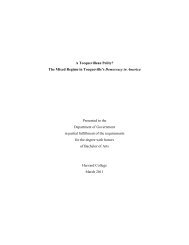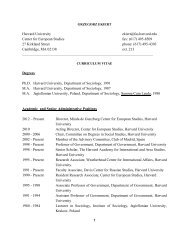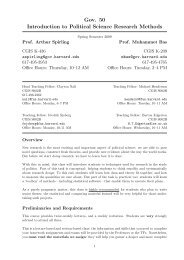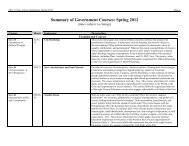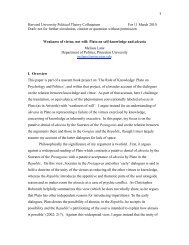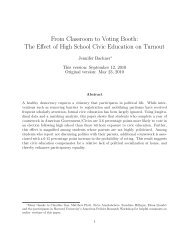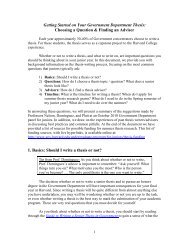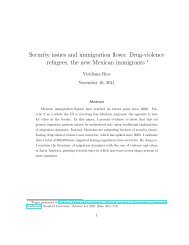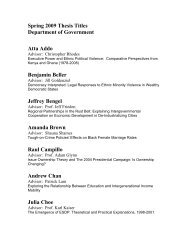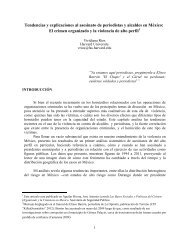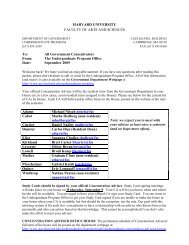Supreme Court Agenda Setting in a System of Shared Powers Ryan ...
Supreme Court Agenda Setting in a System of Shared Powers Ryan ...
Supreme Court Agenda Setting in a System of Shared Powers Ryan ...
Create successful ePaper yourself
Turn your PDF publications into a flip-book with our unique Google optimized e-Paper software.
8 The Journal <strong>of</strong> Law, Economics, & Organization. V0 N0<br />
(A) Inside Legislative Equilibrium<br />
H J S P<br />
(B) Outside Legislative Equilibrium<br />
H S P J<br />
Figure 1. Context and the Separation <strong>of</strong> <strong>Powers</strong>. H=House. S=Senate. P =President.<br />
J=<strong>Supreme</strong> <strong>Court</strong>. In this Figure, the House is the Left Pivot and the President is the<br />
Right Pivot.<br />
4.1 The Median Justice and the Legislative Equilibrium<br />
The first condition that must be met for the <strong>Court</strong> to behave strategically<br />
turns on the location <strong>of</strong> the median justice relative to the legislative equilibrium.<br />
Figure 1 provides a graphical explanation. The House, Senate, President,<br />
and <strong>Supreme</strong> <strong>Court</strong> are all placed along this spectrum. The <strong>Court</strong>’s relation to<br />
these actors is critically important. Figure 1A shows a <strong>Court</strong> that is <strong>in</strong>side the<br />
legislative equilibrium. The <strong>Court</strong> <strong>in</strong> this example is more conservative than<br />
the House (the Left Pivot) and Senate but is less conservative than the president<br />
(the Right Pivot). Under this configuration, the <strong>Court</strong> can set policy at<br />
its ideal po<strong>in</strong>t, J, regardless <strong>of</strong> where the status quo is located because J is<br />
protected. If the House tried to pass override legislation anywhere to the left <strong>of</strong><br />
J the president (and Senate ) would block it. Conversely, if the president proposed<br />
override legislation to the right <strong>of</strong> J, the House would block it. Stalemate<br />
results, with the <strong>Court</strong> able to pursue its s<strong>in</strong>cerely held policy goals. 8<br />
Figure 1B represents a situation <strong>in</strong> which the <strong>Court</strong> may be constra<strong>in</strong>ed because<br />
it is outside the legislative equilibrium. Here, the <strong>Court</strong> is more conservative<br />
than both the Left and Right Pivots and may be vulnerable to override<br />
and punitive legislation, depend<strong>in</strong>g on where the status quo is located. That is,<br />
whether the political branches pursue such legislation depends on the location<br />
<strong>of</strong> the status quo.<br />
4.2 Policy Change and the Status Quo<br />
If the <strong>Court</strong> median falls outside the legislative equilibrium, the <strong>Court</strong> may<br />
f<strong>in</strong>d itself <strong>in</strong> an unconstra<strong>in</strong>ed, semi-constra<strong>in</strong>ed, or constra<strong>in</strong>ed regime, depend<strong>in</strong>g<br />
on the location <strong>of</strong> the status quo. 9 Figures 2 and 3 illustrate. J represents<br />
the median justice’s ideal po<strong>in</strong>t. SQ represents the status quo policy the<br />
<strong>Court</strong> is be<strong>in</strong>g asked to review. L is the leftmost pivotal member <strong>of</strong> the legislative<br />
process. R is the rightmost legislative pivot. SQ ∗ L represents the Left<br />
8. The current example ignores the veto override. I test the impact <strong>of</strong> the veto override below.<br />
9. For a well-developed discussion on the concept <strong>of</strong> “regimes,” see Moraski and Shipan<br />
(1999).



